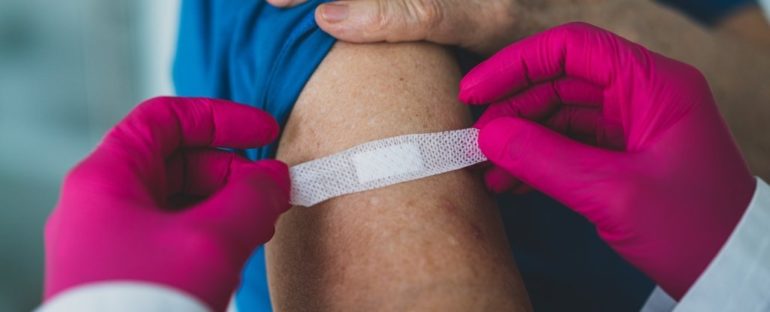An ongoing monitoring system for the safety of mRNA vaccines for COVID-19 has found no serious side effects for either the Pfizer or Moderna shots.
The research is being carried out by federal and private insurance researchers in the United States, with funding and support from the Centers for Disease Control and Prevention (CDC).
Each week since December 14, 2020, the assembled team has followed the medical records of millions of Americans who have received an mRNA vaccine for COVID-19, tracking their health before and after vaccination.
Researchers will continue to monitor vaccinated Americans for the next two years, but in the meantime, the interim results should reassure the public that these new shots are very safe.
Analyzing the medical charts of 6.2 million people with one dose of an mRNA vaccine and 5.7 million people with two doses, researchers found no statistical evidence to connect the shots with any of 23 serious outcomes.
The list is hardly comprehensive, but each possible side effect was ultimately chosen in conjunction with CDC experts based on emerging concerns, hypothetical connections, and initial findings from clinical trials.
The outcomes scientists looked for included neurological disorders, such as seizures, encephalitis, and Guillain-Barré syndrome, cardiovascular problems, like myocardial infarction, stroke, and pulmonary embolisms, and other serious conditions, like Bell’s palsy, appendicitis, and anaphylaxis.
Compared to unvaccinated people and people vaccinated with an mRNA vaccine more than 3 weeks previous, those who had received their shot in the past few weeks did not show more serious health effects.
While some serious side effects occurred very rarely, the authors say none of the associations were strong enough to exceed a pre-specified ‘signal’ threshold, which is needed to be statistically significant.
“The results of this study are a great example of how seriously CDC takes vaccine safety, and how thorough and transparent we are in our safety monitoring efforts,” says Tom Shimabukuro, the deputy director of the CDC’s Immunization Safety Office.
“It is our top priority to do the science and communicate quickly and clearly with healthcare providers and the public, as COVID-19 vaccines continue to undergo the most intensive safety monitoring in US history. Getting vaccinated remains the best way to protect yourself and your loved ones against a virus that has taken millions of lives.”
To build trust in the vaccines, the ongoing safety study has directly addressed emerging concerns from the public. Recent worries around COVID-19 vaccines and blood clots, for instance, have prompted researchers to study thromboembolic outcomes in mRNA vaccines.
Unlike the AstraZeneca vaccine, which relies on a modified cold virus to provoke an immune response to SARS-CoV-2, researchers ultimately found no evidence to link mRNA vaccines, like Pfizer or Moderna, to an increased risk of blood clots.
Heart inflammation from the vaccine has also recently popped up as a concern, especially among younger people who get vaccinated. An analysis of all ages vaccinated so far, however, found no significant association between myocarditis or pericarditis and mRNA vaccines.
In the current study, only 34 cases of heart inflammation were identified among young people, aged 12 to 39. This usually happened within a week of receiving the vaccine, and nearly all the patients recovered by the time the chart review had taken place.
For every million doses of these vaccines given, the authors calculate there will be 6.3 additional myocarditis cases in this age group, which isn’t enough to cross the ‘signal’ threshold, and which many scientists have pointed out is probably lower than the risk of developing myocarditis from COVID-19.
Younger patients should therefore be aware of the risk-benefit trade-off that vaccines pose in a global pandemic, and the symptoms they should be on the look-out for if they do choose to get vaccinated.
Any serious side effects connected to the vaccine seem extremely rare, which means getting vaccinated is still, by far, the safest measure this age group can take to protect their health. Especially when medical providers are there and ready to assist if anything goes wrong.
Among millions of participants, for instance, scientists could only confirm 55 cases of severe allergic reactions after vaccination, and most of these cases occurred within the first thirty minutes of receiving the vaccine when patients are usually closely monitored.
“The world is relying on safe and effective vaccines to bring an end to the COVID-19 pandemic,” says Nicola Klein, the director of the Kaiser Permanente Vaccine Study Center.
“The Vaccine Safety Datalink is ideally suited to carry out this important surveillance and we will continue to monitor the safety of all vaccines that protect against COVID-19.”
The data collected so far only take us to June 26, 2021, but given how important it is to maintain trust in the safety and efficacy of COVID-19 vaccines, the research is far from over.
While phase III clinical trials can help identify any obvious health risks, their limited sample size, restrictive inclusion criteria, and limited follow-up are limitations that might miss important outcomes.
That’s why all new vaccines in the US continue to be monitored once they are widely distributed, so that if anything goes wrong, we can act fast.
The new COVID-19 vaccines are no exception, but given that mRNA vaccines are relatively new territory, it’s especially important the safety findings are reported to the public in clear terms.
As of now, the results show Pfizer and Moderna vaccines for COVID-19 are a much safer option than contracting the novel coronavirus itself.
The study was published in JAMA.



